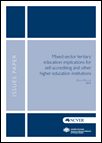Description
Growth in mixed-sector institutions offering both vocational and higher education qualifications is expected to increase given recent and predicted policy changes. This issues paper focuses on the nature of VET provision within institutions accrediting their own higher education programs, most of which are large public universities, and other tertiary education institutions, primarily smaller private providers. It complements previous research on higher education in TAFE. Issues raised for discussion include the broadening role of various providers, governance and funding issues, organisational structures and the implications of mixed sector provision for students, staff and the future of institutions.Summary
About the research
'Mixed-sector' institutions are relatively new in Australia, but numbers are likely to increase as the boundaries between vocational education and training (VET) and higher education become increasingly blurred.
In 2009 the National Centre for Vocational Education Research (NCVER) published research examining the nature of higher education offered by public VET providers (Higher education in TAFE by Leesa Wheelahan, Gavin Moodie, Stephen Billett and Ann Kelly 1 ).
Gavin Moodie and his colleagues are continuing their research and this paper has been written with the intention of provoking discussion. It presents an initial account of mixed-sector tertiary education in Australia—separating institutions accrediting their own higher education programs, most of which are large public universities, from other tertiary education institutions, primarily smaller private providers.
A range of issues about the emerging character of mixed-sector provision is flagged and will be considered as part of the research, including:
How relevant will the sector designations be if the distinctions relating to tertiary education continue to blur, and if Australian governments allocate public support for teaching by mechanisms that do not distinguish between types of institutions?
To what degree is mixed-sector provision affected by the extent to which the smaller sector is integrated with an institution's organisational structure, the level of the organisation at which vocational and higher education are integrated and the level of autonomy granted to organisational units?
What are the implications of mixed-sector provision for the students, staff and institutional futures?
Dr Moodie has indicated that he welcomes any response to this paper.
Tom Karmel
Managing Director, NCVER
Related items
This research suggests that while mixed-sector and dual-sector providers are still only small in num… Show more
This research overview provides the key messages arising from two related projects investigating ter… Show more
